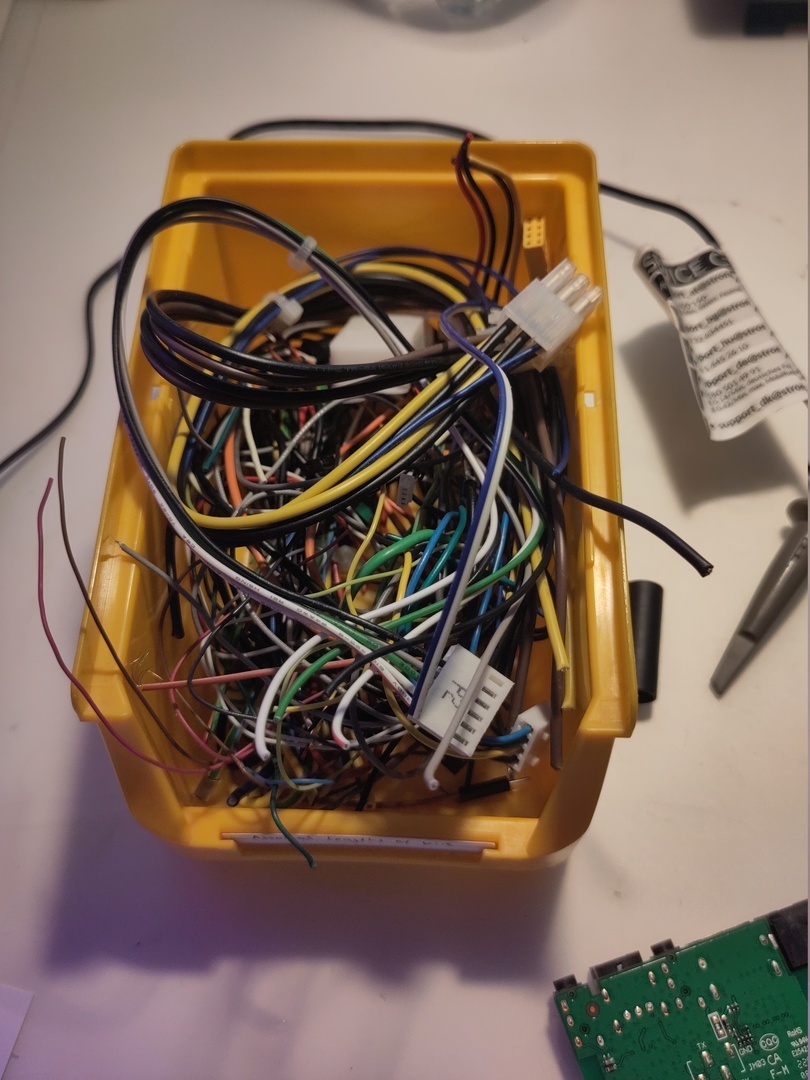The Approximately Monthly Zoomer
A Giant Leap-S1 for Mankind
2024-04-08
Hardware hacking has always been a little scary for me. Mostly because opening and disassembling hardware would sometimes render it unusable due to my low dexterity stat - much to the dismay of those who still wanted to use the device and couldn’t appreciate the immeasurable amount of invaluable knowledge that stands to be gained from dissection. Nonetheless I’ve recently decided to dip my toe into some hardware hacking again.
The Target
The Leap-S1 is an android tv box which uses the Amlogic S905X2 SoC
with an ARM Cortex-A53, can output in 4k60Hz, has 2GB of RAM and 8GB of
flash. Like all android tv boxes it comes with a lot of Goolag bloat
that is neither necessary nor privacy-friendly. So how about we install
something else on it, like coreelec,
since android is basically linux anyway. The adb shell on
the box doesn’t really have lots of permissions to poke around. Maybe
there is a uart connector somewhere that we could use to get a shell
with more privileges.
What’s in the Booox?
Warranty void stickers are a meme anyway so let’s open the box and see what’s inside.

No obvious uart connections. Let’s check the bottom.

Bingpot! That’s as clear a uart as you can get but let’s make sure by identifying the pins.
UART
The GND pin is unsurprisingly connected to the ground, as can easily be checked with a multimeter in continuity mode. Again with a multimeter we can check the other pins while the box is booting and we’ll see that while 3.3V and RX stay at the same voltage throughout the boot process, the voltage on the TX pin fluctuates around 2V. Realistically, there is no way this is anything other than uart, but just to double-check and find out the baud rate, we can connect the TX pin to an oscilloscope and see what’s going on there.

We can see that the shortest pulse is around 8.7μs and if we want to
be a little more precise we can measure the length of a few pulses and
divide by how many of those shortest pulses fit inside the whole. Here I
measured the length of ten bits - from left to right we can see that the
bits are 0110110001. The cursors of the oscilloscope are positioned at
the beginning and at the end of the sequence and the oscilloscope tells
us, that it takes 86.8μs for all ten bits - which is 8.68μs per bit. We
can now take the reciprocal 1/(8.68*10^-6) and this gives
us a frequency of 115207Hz, which we also get by multiplying the
11.52kHz displayed underneath the time measurement on the oscilloscope
by ten. Baud rates are not arbitrary, there is only a set of predefined
speeds for serial communication, so even if your oscilloscope is not the
most precise, we can still get an idea of what baud rate is being used
by looking at the closest possible rates. Our calculated speed is too
fast for 76800 and too slow for 128000 and pretty much dead-on for
115200.
Chinesium Arduinos
If you short the reset and ground pin of an
arduino, you can use it as a “dumb” USB to TTL converter. Just hook up
RX to RX and TX to TX and you have yourself an adapter. This
should also work with the arduino clones that use a CH340
series chip but it didn’t work for me. Before buying some sort of UART
to USB adapter, I thought I’d check if I have some other
microcontrollers and as it turned out I had an ESP8266-based NodeMCU
(not sure if knockoff or not) which also used a CH340 chip. Not giving
it much thought I tried the same thing - short reset to ground, TX to
TX, RX to RX, ground to ground.


I plugged in the NodeMCU, started my serial communication program
with picocom -b 115200 -r -l /dev/ttyUSB0, powered on the
android tv box, and to my sheer delight there was a bootlog flying
across my terminal!
Field Programmable Google AndroidTV
To make it a little easier to connect to the uart interface I wanted to solder some sort of cables or connector to the exposed pads. Luckily I have a drawer with Assorted Lengths of Wire™ for just such occasions!

I soldered the wires to the TX and RX pins, wrapped them around the board and made a hole in the case with a soldering iron.

Slap the bottom of the case back on that bad boy and we can access the uart “in the field” any time we want.

I forgor 💀
Since I just used some exposed metal as ground when I was investigating the board with my oscilloscope, I totally forgot to add a ground wire as well. Luckily ground is shared by all components and connectors so I just used an old 3.5mm audio cable and cut it open so I can use its ground when connecting using uart.
No Shell? 🥺
Starting kernel ...
uboot time: 7182164 usIt seemed like the boot process was completed and the kernel was loaded, surely that means we have an interactive shell now, right? Not really. It didn’t look like I could interact with the box over uart while it was booting at all - so what do we do now?
Inspecting the Bootlog
One section in particular caught my eye.
USB0: USB3.0 XHCI init start
Register 3000140 NbrPorts 2
Starting the controller
USB XHCI 1.10
scanning bus 0 for devices... 1 USB Device(s) found
scanning usb for storage devices... 0 Storage Device(s) found
** Bad device usb 0 **
[sk_usb_cfg_init,422]load file "/skyworth/factory_mode/uboot/check_udisk.cfg" from u disk failed!
[sk_boot,182]general boot.It caught my eye because the file path was literally red! Apparently
the bootloader looks for a specific file on a USB drive. Poor
bootloader, let’s give him the file. If we add
boot_mode="boot flash recovery" to the file we can even
make it boot into recovery mode.
Pop Pop!
It looks like the bootloader liked our file.
USB0: USB3.0 XHCI init start
Register 3000140 NbrPorts 2
Starting the controller
USB XHCI 1.10
scanning bus 0 for devices... 2 USB Device(s) found
scanning usb for storage devices... init_part() 282: PART_TYPE_DOS
1 Storage Device(s) found
33 bytes read in 36 ms (0 Bytes/s)
[sk_boot,220]boot recovery from flash.We’ve successfully booted into recovery mode and we even have a shell with a nice looking number sign.
# id
uid=0(root) gid=0(root) groups=0(root) context=u:r:shell:s0Indeed, we are root and found a good place to start our recon and here’s what I’ve found after a very uncoordinated and brief attempt:
BusyBox v1.22.1 staticis installeduname -asaysLinux localhost 4.9.180 #1 SMP PREEMPT Mon Mar 14 11:08:10 CST 2022 armv8l- U-Boot version is
2015.01
I’m sure I’ll find the motivation to keep digging soon. It can only be a matter of months.
Proxmox is not that hard
2023-02-12
As it turns out, having a single server run a host (no pun intended) of different things on the same operating system can lead to some weirdness. Having some form of separation between the processes can be helpful - many choose containers and virtual machines and so did I.
Proxmox
For me, the decision to install proxmox came about when I realized, that I experimented less and less on my server for fear of breaking something and causing downtime to the services I want to be locally available all the time. Being able to experiment inside a VM and restore it from a backup or throw it away should the need arise has definitely had a very positive impact on my peace of mind.
With regular snapshots of my minecraft server, I don’t have to worry about my so-called friend playing a practical joke on my meticulously constructed mob grinder.
By using proxmox’s potent klickibunti for managing drives, I was able
to combine all the old vintage SSDs lying around my
house into a single ZFS pool for the less important stuff on my server.
While proxmox does have a nice way of viewing S.M.A.R.T. data and
creating snapshots and backups of VMs, I’d rather not put my precious
minecraft world saves that pool specifically.
One of the programs running on my server leaks RAM. Even though I love going through other people’s spaghetti and fixing RAM leaks, periodically restarting the program’s container seems to be a more pragmatic solution. And with proxmox I can even see its RAM usage over time.

Even if you don’t feel like using any kind of orchestration tool for your containers or config management for your VMs (yet), proxmox is a powerful tool. New VMs and Containers can be set up very easily, the snapshot and backup system is very versatile, and if you’re ready to spend some money you can use its HA tools to migrate VMs to a different node while they’re running. Installing it is as easy as it is to install debian, if not easier. 10/10 would recommend.
Can we please go back to paper menus?
2023-01-06
My brother in Christ, I do not need assistance with scanning a QR code, just give me the frickin’ paper menu!!!!11!1!
Recently I’ve let a restaurant ruin my mood by using a buggy menu behind a QR code instead of handing me a proper menu and that made me think, so here are all the reasons I could come up with in the shower about why we should reject modernity, embrace tradition, and use good old-fashioned paper menus.
Why would I want to look at a tiny screen smaller than my hand instead of a large (paper) menu with a large font with godlike contrast that can display more than a few lines at a time?
SoMeBoDy tHiNk oF tHe cHiLdReN - but unironically. Not all children who are capable readers posess a smartphone or should be encouraged to use one during a meal.
I don’t want to be advertised to on a restaurant menu you greedy fucks. Louis Rossmann had a similar experience where the first thing he saw after loading the site were three advertisements that blocked nearly all of the page.
Cookies - but not the kind you want at a restaurant. Clicking through dark-pattern cookie dialogues just to order food in a restaurant. Welcome to the world of tomorrow!
Security - If someone on the street handed you a QR code to scan and said “trust me bro, it’s 100% safe and legit” I’m sure you’d do exactly as asked. Bonus points if the site allows you to directly pay by credit card. Also, what about exploits in the QR scanning software or just regular browser exploits? What if some non tech-savvy senior gets tricked into downloading the offishal™ restaurant app? Or someone leaves a fake QR code at the table?
Tracking scripts. Why do goolag and friends need to know where I’ve been eating?
Poor web design - Clicking back and forth through categories/menus just so you can see the appetizers, main courses, side dishes and desserts separately. And god forbid you want to see the ingredients, that’s another click on the item and scroll down. Then you have to click the back button which doesn’t bring you back to the same place on the page but all the way to the top.
It distracts. Looking at your phone there will certainly be some other things that may disctract you, your friend texting you, a missed call from your coworker, a calendar reminder, any notification really. I for one don’t have the mental fortitude to block out all those stimuli and focus solely on looking at the menu in my browser, and neither do some of my friends, who ended up spending a large amount time checking other notifications every time they went to take a look at the menu.
We’re inside, in a large building. Large buildings have lots of walls, lots of thick walls. Mostly from reinforced concrete, which has a pretty high linear attenuation coefficient. An internet connection is needed to load all the fancy 4K pictures of the food. Do you see where I’m going with this? They already have reception problems with their GSM credit card reader, waving it around trying to catch some bytes floating around the ether, let alone downloading high res pictures.
Public WiFi. That fancy new speakeasy you can only enter with a password is in a basement? No need to worry about reception, just use their free WiFi! Yeah, sure. Even if you’re so inebriated that connecting to a public and unencrypted WiFi seems like a good idea, what do you think will happen when everyone tries to open the menu at once using their shit-tier ISP-provided 54mbps dsl 802.11g router? What about the couple sitting in the other corner away from the router?
The Good Things
Not everything about those QR menus is bad, there are some small benefits, but most have one thing in common: only the restaurant benefits from it.
You can change prices on a whim! No more reprinting menus, just a few clicks in your POS (both meanings) system and you can adjust for real-time inflation should you live in Argentina. Someone with gucci crocs and a rolex just walked in? Have the QR code on their table link to a more suitable “premium” menu!
You save money and trees by not printing paper menus. Well yes, but actually no. Most of the time they still have good old-fashioned cellulose menus as a backup, so those trees are already dead.
When combined with an ordering system, you can fire some of the staff and keep more of the profits to yourself.
That’s it?
Unless you completely dread social interaction with waiters and holding menus other people have held before you (why are you at a reastaurant then?), I fail to see how menus behind QR codes benefit you, the customer, in any way.
To PHP or not to PHP
2022-12-06
Up until now my blog has been using PHP with a MySQL database to store blog entries. It was a nice exercise to try PHP again, every year the language becomes more and more bearable. However, it always seemed a bit overkill for what I’m trying to achieve: a few pages with nicely laid out text.
Why now?
I’m currently in the process of migrating all of my services onto a Proxmox cluster, so I guess now is as good a time as any.
The New, Better, Improved and 100% Future-Proof System
My blog neither has a lot of posts nor frequent updates, so a search function is something I can procrastinate doing for now. This means there is no need for anything else than a few static pages. The general idea I had was to write articles in markdown and have them converted into html. Without checking I was certain such a program already existed so I started thinking about the rest of the setup. I settled on a python script which takes the markdown files, which have a few lines of metadata at the beginning, and passes them to pandoc for conversion using templates. Since the python script runs on my local machine with trusted™ files and not on the server itself, I sleep with a clear conscience each night, knowing the security of the script and sanitizingh the input is not a thing to worry about.
Challenges
Passing one article to an html template is not a big deal, but what if you want three articles on the same page? Let’s say on the landing page? Templates within tempates? How do you use templates all the way down?
Turns out I don’t even know how to google that, so instead I’ll just generate the articles with pandoc and then manually insert multiple into a single page using a python script.
Et voilà
It’s better than good - it’s good enough! I’m happy with the way it turned out. To some it might be ugly spaghetti code, to others it might be pretty spaghetti code - either way, it’s my spaghet and I’m proud of it.
